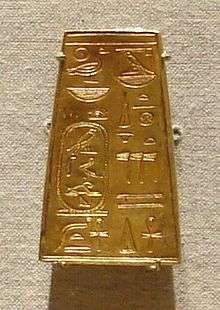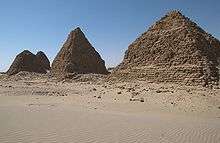Napata
Coordinates: 18°32′N 31°50′E / 18.53°N 31.84°E
| Napata in hieroglyphs | ||||
|---|---|---|---|---|
|
npt | ||||


Napata was a city-state of ancient Nubia on the west bank of the Nile at the site of modern Karima, Sudan.
Early history
Napata was founded by Thutmose III in the 15th century BCE after his conquest of Nubia. The nearby Jebel Barkal was taken to mark the southern border of the New Kingdom of Egypt.
In 1075 BCE, the High Priest of Amun at Thebes, capital of Egypt, became powerful enough to limit the power of Pharaoah Smendes of the post-Ramesside Twenty-first Dynasty over Upper Egypt. This was the beginning of the Third Intermediate Period (1075–664 BC). The fragmentation of power in Egypt allowed the Nubians to regain autonomy. They founded the Kingdom of Kush, which was centered at Napata.
Napatan period
In 750 BC, Napata was a developed city, while Egypt was still suffering political instability. Kashta, whose name is Egyptian for "the Kushite", profited from it, and attacked Upper Egypt. His policy was pursued by his successors Piye, and Shabaka (721–707 BC), who eventually brought the whole Nile Valley under Kushitic control in the second year of his reign. Overall, the Kushite kings ruled Upper Egypt for approximately one century and the whole of Egypt for approximately 57 years, from 721 to 664 BCE. They constitute the Twenty-fifth Dynasty in Manetho’s Aegyptiaca.
The reunited Egyptian empire under the 25th dynasty was as large as it had been since the New Kingdom and ushered in a renaissance.[1] Religion, the arts, and architecture were restored to their Old, Middle, and New Kingdom forms. Pharaohs, such as Taharqa, built or restored temples and monuments throughout the Nile, including at Memphis, Karnak, Kawa, Jebel Barkal, and elsewhere.[2]
Assyrian invasion and end of the Nubian dynasty
Pharaoh Taharqa's reign and that of his eventual successor, his cousin Tantamani, were filled with constant conflict with the Neo-Assyrian Empire. Around 670 BC, emperor Esarhaddon (681–669 BCE) conquered Lower Egypt, but allowed local kingdoms there to exist in order to enlist them as his allies against the Kushite rulers of Upper Egypt, who had been accepted with reluctance.
When King Ashurbanipal succeeded Esarhaddon, the Kushite king Taharqa convinced some rulers of Lower Egypt to break with Assyrians. However, Assurbanipal overpowered the coalition and deported the Egyptian leaders to his capital, Nineveh. He appointed the Libyan chief Necho, ruler of Memphis and Saïs. Necho I was the first king of the Twenty-sixth Dynasty (664–525 BC) of Egypt, which is also known as the "Saïte Dynasty".
In 664 BCE, the Assyrians laid the final blow, sacking Thebes and Memphis. The same year, Taharqa died. The new Kushite king, Tantamani (664–653 BCE), killed Necho I that same year when he tried to invade Lower Egypt. However, Tantamani was unable to defeat the Assyrians, who backed Necho’s son, Psamtik I. Tantamani eventually abandoned his attempt to conquer Lower Egypt and retreated to Napata. However, his authority over Upper Egypt was acknowledged until the 8th regnal year of his reign at Thebes (or 656 BC), when Psamtik I dispatched a naval fleet to Upper Egypt and succeeded in placing all of Egypt under his control.
The 25th dynasty ended with its rulers retreating to Napata. It was there (at El-Kurru and Nuri) that all 25th dynasty pharaohs are buried under the first pyramids that the Nile valley had seen since the Middle Kingdom.[3][4][5]
The Napatan dynasty continued to rule the Kushite state, which flourished in Napata and Meroë until at least the second century AD.
Late Napatan kingdom

Napata remained the centre of the Kingdom of Kush for another two generations, from the 650s to 590 BC. Its economy was essentially based on gold, with 26th dynasty Egypt an important economic ally.
Napatan architecture, paintings, writing script, and other artistic and cultural forms were in Kush style. Egyptian burial customs were practised, including the resurrection of pyramid building. Also, several ancient Egyptian deities were worshipped. The most important god was Amun, a Theban deity, and the Temple of Amun was the most important at Napata, located at the foot of Jebel Barkal.[6]
After the Achaemenid conquest of Egypt, Napata lost its economic influence. The Napatan region itself was desiccating, leading to less cattle and agriculture. An Achaemenid raid had seriously affected Napata in 591 BCE. Finally, Napata was losing its role of economic capital to Meroë. The island of Meroë, the peninsula formed by the Nile and the Atbarah River, was an area rich in iron, which was becoming an essential source of wealth. Meroe eventually became the capital of the Kingdom of Kush, leading to the abandonment of Napata.
In 23 BC, the Governor of Roman Egypt invaded Kush after an initial attack by the queen of Meröe, razing Napata to the ground. In the Res Gestae Divi Augusti ("Deeds of the Divine Augustus"), Augustus claims that "a penetration was made as far as the town of Napata, which is next to Meroe[.]"[7]
Cultural references
Napata was mentioned in Giuseppe Verdi's opera Aida (1871) in Act III, when Amonasro uses Aida to learn where Rhadames will lead his army.
References
- ↑ Diop, Cheikh Anta (1974). The African Origin of Civilization. Chicago, Illinois: Lawrence Hill Books. pp. 219–221. ISBN 1-55652-072-7.
- ↑ Bonnet, Charles (2006). The Nubian Pharaohs. New York: The American University in Cairo Press. pp. 142–154. ISBN 978-977-416-010-3.
- ↑ Mokhtar, G. (1990). General History of Africa. California, USA: University of California Press. pp. 161–163. ISBN 0-520-06697-9.
- ↑ Emberling, Geoff (2011). Nubia: Ancient Kingdoms of Africa. New York: Institute for the Study of the Ancient World. pp. 9–11. ISBN 978-0-615-48102-9.
- ↑ Silverman, David (1997). Ancient Egypt. New York: Oxford University Press. pp. 36–37. ISBN 0-19-521270-3.
- ↑ World Studies The Ancient World Chapter 3 Section 5 Pages 100, 101 and 102
- ↑ Augustus, "The Deeds of the Divine Augustus," Exploring the European Past: Texts & Images, Second Edition, ed. Timothy E. Gregory (Mason: Thomson, 2008), 119.
- Hornung, Erik. 1999. History of Ancient Egypt: An Introduction. Translated from German by David Lorton. Grundzüge der ägyptischen Geschichte. New York, USA: Cornell University Press. ISBN 0-8014-8475-8.
- Grimal, Nicolas. 1992. A History of Ancient Egypt. Translated from French by Ian Shaw. Histoire de L’Egypte Ancienne. Oxford, UK: Blackwell Publishers. ISBN 0-631-17472-9.
- Bianchi, Robert Steven. 1994. The Nubians: People of the Ancient Nile. Connecticut, USA: Millbrook Press. ISBN 1-56294-356-1.
- Taylor, John. 1991. Egypt and Nubia. London, UK: The British Museum Press. ISBN 0-674-24130-4.
- UNESCO. 2003. General History of Africa vol.2 Ancient Civilizations of Africa. Berkeley, CA: University of California Press. ISBN 0-435-94806-7.